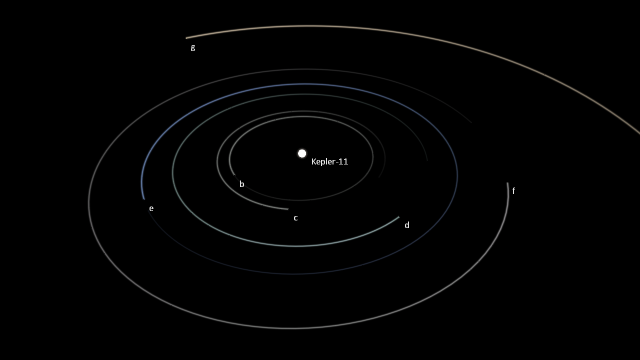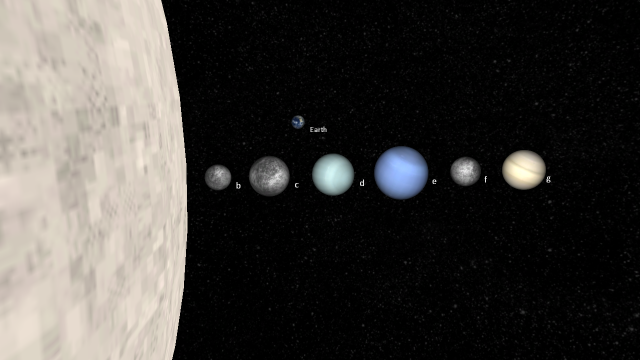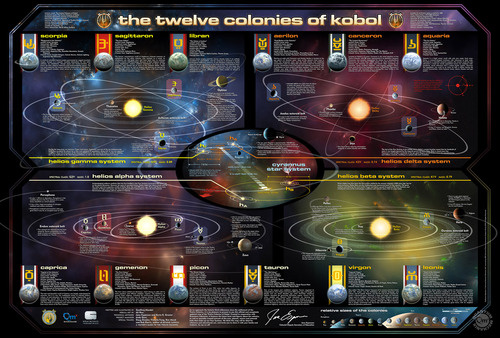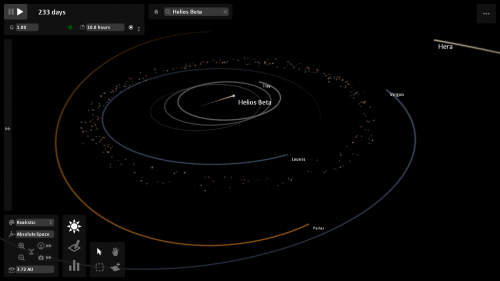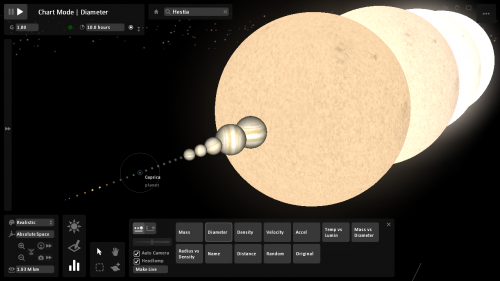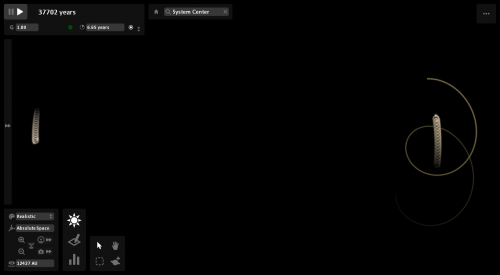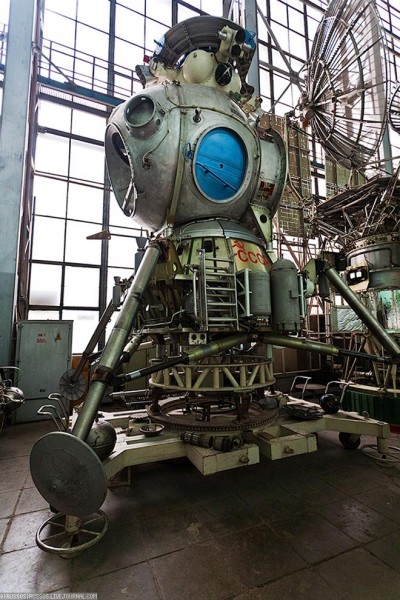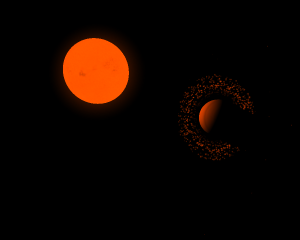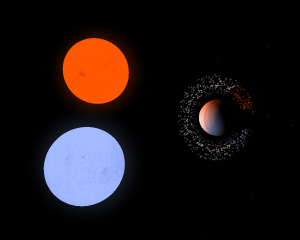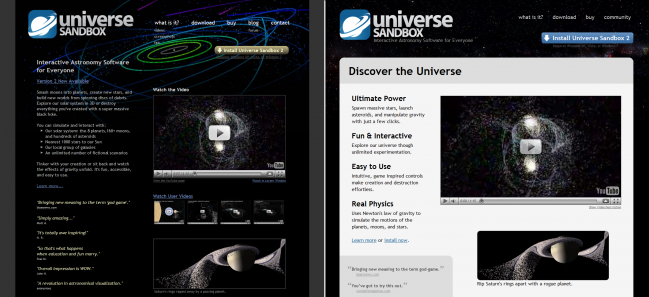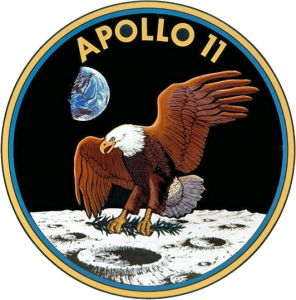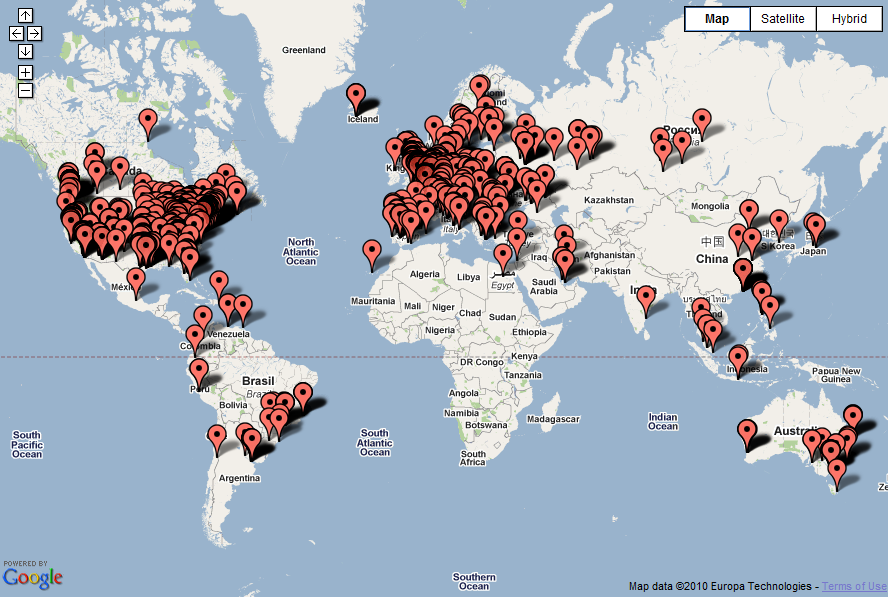Dan Dixon
This user hasn't shared any biographical information
Jabber/GTalk: sandbox
Posts by Dan Dixon
Six Planet Solar System Discovered
Feb 3rd
The Kepler space telescope, designed to find planets around other stars, has found an amazing little solar system. Affectionately named Kepler-11, this solar system has 6 planets (all larger than the Earth), with 5 of those planets in a super close orbit to their Sun like star.
Open the Kepler-11 simulation on your computer
- Download & Install Universe Sandbox (it’s free and includes a 60 minute trial of all the premium features)
You may want to run through the short tutorial to get a feel for how to navigate in the simulator. - Download the Kepler-11 Solar System simulation.
- Open the simulation by either dragging the downloaded file into the Universe Sandbox window or by double clicking on it.
Check out the Bad Astronomer’s article for more on how humanity made this discovery.
.
Here’s a view of the complete Kepler-11 system. Note the size of the Sun is to scale with the entire simulation (it hasn’t been scaled up). The orbit of our Mercury (the closest planet to our sun), would be just slightly inside the orbit of g. In Universe Sandbox you can turn on the Solar System grid to clearly see this comparison.
.
Universe Sandbox’s Chart mode, by distance, view of the system. The colors and textures are mostly guesses, but astronomers are quite certain of the sizes. I’ve included our Earth for comparison. The white mass on the left is the Kepler-11 sun.
More Information
Twelve Colonies
Jan 28th
Earlier today I saw Bad Astronomy’s post about a Twelve Colonies map created by one of the writers and the science advisor for the new Battlestar Galactica series. I’m a big fan and always wondered how all the different colonies mentioned in the show related to one another.
I forwarded the link to a good friend (who I introduced to the series) and mentioned how this would make an excellent Universe Sandbox simulation (since there was so much data about sizes and distances). She emailed back with the encouragement to make and post it today so I spent the rest of the day creating a Universe Sandbox simulation of the Twelve Colonies of Kobol.
Open the Twelve Colonies simulation on your computer
- Download & Install Universe Sandbox (it’s free and includes a 60 minute trial of all the premium features)
You may want to run through the short tutorial to get a feel for how to navigate in the simulator. - Download the Twelve Colonies Simulation.
- Open the simulation by either dragging the downloaded file into the Universe Sandbox window or by double clicking on it.
This mathematically accurate simulation of the 4 stars and 12 colonies can be viewed with either the Free or Premium version of Universe Sandbox 2.
Here’s a screenshot from Universe Sandbox of the Helios Beta system (the star system in the lower right corner of the above map):
Here’s how Caprica stacks up in comparison to the other planets and the four stars:
Just click the Chart Mode button to see this view for yourself. It looks like this:
![]()
Simulation Features
- Each pair of star orbits each other and the two sets also orbit each other (around their barycenter).
- Caprica and Gemenon orbit their barycenter which is in orbit around Helios Alpha.
- Aerilon and Canceron are at the L4 and L5 point of Delta and Hestia.
Simulation Notes
- Star masses from the map were assumed to be relative to our real Sun.
- All colony planets were hand placed within each stars habitable zone (a feature in Universe Sandbox).
- I had to move Ragnar out by another 800 SU/AU in order for its orbit around the barycenter of Delta and Gamma to be stable.
- If you run the simulation at a fast time step the planets will get thrown out, but it will show how the stars orbit each other.
- No moons are included in this version.
- All the colonies are using the same planet texture. (A planned update to Universe Sandbox will address the lack of texture variety.)
- The ubox simulation file is fully editable using the built-in file tools in Universe Sandbox.
More info
- io9’s post with interview of the map creators
- Bad Astronomy’s post about the map
- Wikipedia Article on the Twelve Colonies
And a final screenshot that shows how the stars are all orbiting each other:
The stars Alpha and Beta are orbiting each other on the left and Gamma and Delta are on the right. The other larger spiral is the Ragnar planet that orbits the barycenter of Gamma and Delta. To create this shot I deleted all the planets (save Ragnar), increased the time step, and lengthened the trails. This is showing the extent of the entire simulation as shown in the center of the original star map.
Russian Moon Landing that Never Was
Oct 15th
The history of the Russian’s attempt to land a human on the Moon is fascinating. Here’s a great collection of images of their lunar lander from Wired:
Sneak Preview of New Features
Aug 26th
Here are a couple screenshots of some of the new lighting features I’ve been working on.
There’s still quite a bit to do: stomping out various bugs, solving edge cases, and integrating the new features into the user interface. I plan to release these new features in the next update of both the free and premium versions of Universe Sandbox 2.
One the left is Wolf 359 one of the closer stars to Earth at only 7.8 light years away next to Saturn and its rings. Wolf 359 really is that small, just a bit larger than Saturn and I’ve brightened it up (as it is really dim in reality). On the right I’ve added a second Wolf 359 and changed its temperature to a much hotter color.
Let me know what you think of the new lighting features in the comments…
New Website
Aug 25th
The new website for Universe Sandbox is now live.
Compare screenshots of the old site (left) and new site (right):
Click on the image to zoom.
Details of the website transformation:
- Simplified the overall look. Moved to a white page (vs black).
- Consolidated the FAQs into a single page.
- Added new screenshots of the version 2 interface.
- Site now folder based (no file extensions like htm, html, or php)
- New header and background for both the forum and blog.
- Revised Install button and added it to the blog and forum headers.
- Set width of blog to 960px (like both the forum and the main site)
- Fixed forum main page title (was ‘Universe Sandbox – index’, now ‘Universe Sandbox | forum’)
- Fixed problem with icons never appearing for forum actions, like ‘New Post’.
- Updated favicon for the site.
Let me know what you think in the comments. I value feedback.
We Landed on the Moon 41 Years Ago
Jul 20th
Today marks the 41st anniversary of humanity landing on the moon. Let’s go back soon.
More information
NASA Releases Free Video Game
Jul 6th
NASA has just released a free multiplayer video game called Moonbase Alpha.
You play as an astronaut on the moon repairing damage to your base after an asteroid hits nearby. Moonbase Alpha showcases a small piece of a more comprehensive multiplayer astronaut game that’s in the works called Astronaut: Moon, Mars and Beyond.
What do you think of the game? Let everyone know in the comments below.
Learn more about Moonbase Alpah on the official NASA website
Astronaut: Moon, Mars and Beyond
Visitors From All Over the World
May 2nd
Our Sun is Amazing
Apr 21st
NASA’s Solar Dynamics Observatory, a brand new spacecraft launched in February, has began sending back the most amazing and highest quality images of the sun ever taken by humanity.
More amazing images and video
http://science.nasa.gov/science-news/science-at-nasa/2010/21apr_firstlight/
Official site of the spacecraft
http://sdo.gsfc.nasa.gov/
Wikipedia Article
http://en.wikipedia.org/wiki/Solar_Dynamics_Observatory
Our Earth is Constantly Bombarded
Apr 15th
Space is constantly raining down about 100 tons of interplanetary material each day. Usually it’s just dust, but sometimes it’s in larger chunks that crashed into the State of Wisconsin (United States) last night (on April 14, 2010).

